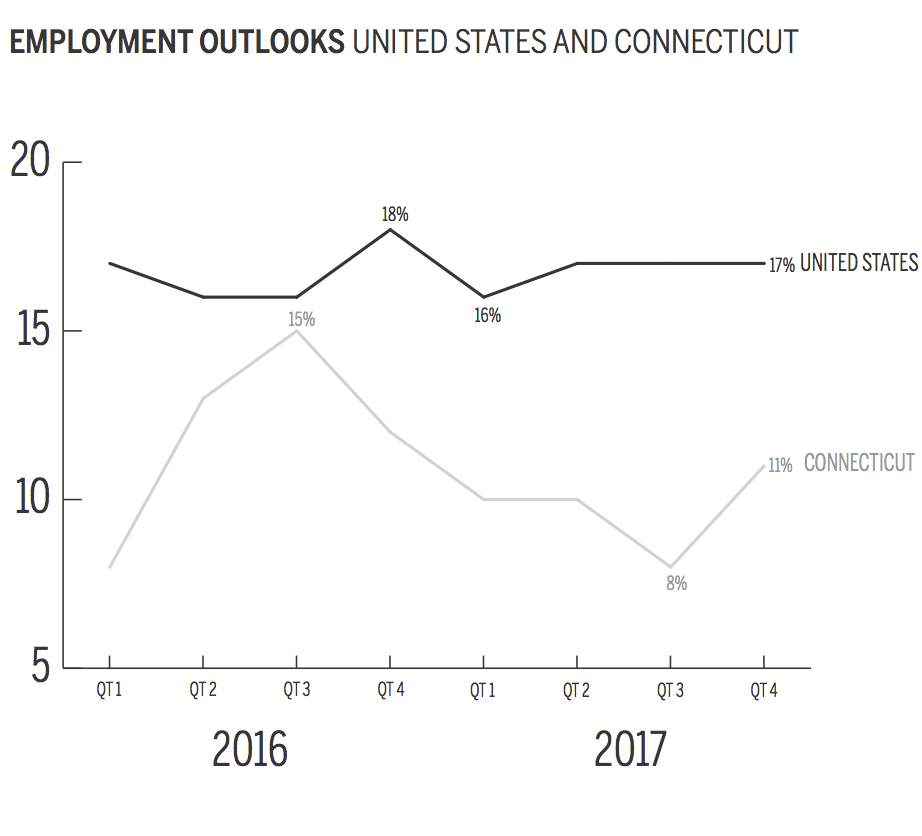
Connecticut’s hiring projections bode well for employment in the state, but fall short of the national average, according to a survey conducted by ManpowerGroup, an American Fortune 500 staffing firm.
According to the ManpowerGroup Employment Outlook Survey, 18 percent of Connecticut employers plan to increase their head counts from October to December 2017, compared to 21 percent nationally, reflecting an overall increase in hiring projections from the previous quarter. Seven percent of Connecticut employers plan to reduce their payrolls, another 73 percent expect to maintain their current workforce levels and 2 percent are uncertain of their hiring plans. Taking into account these trends, the ManpowerGroup survey gave the state a “Net Employment Outlook,” an indicator of employment pace, of 11 percent.
“This figure is derived by taking the percentage of employers anticipating an increase in hiring activity and subtracting from this the percentage of employers expecting to see a decrease in employment at their location in the next quarter,” said Danielle Switalski, spokeswoman for the ManpowerGroup, in an email to the News.
The national Net Employment Outlook for the fourth quarter of 2017 is 17 percent, marking the 13th consecutive quarter with an Outlook of 15 percent or stronger for the United States. At 11 percent, the Net Employment Outlook for the state of Connecticut is relatively modest.
For the New Haven-Milford area, the Net Employment Outlook is 10 percent. Of employers surveyed, 16 percent plan to hire more employees for the remainder of the year, while 6 percent plan to reduce payrolls, 76 percent expect to maintain current staff levels and 2 percent are unsure of their hiring plans.
“Hiring intentions are positive in all U.S. regions and industry sectors,” Switalski said.
Job prospects in Connecticut appear strongest in construction, durable goods manufacturing, wholesale and retail trade, professional and business services, education and health services and leisure and hospitality, according to the report. Government employers, on the other hand, plan to reduce staffing levels, and hiring in transportation and utilities is expected to remain unchanged.
Peter Gioia, vice president and economist at the Connecticut Business and Industry Association, expressed concern at the survey results.
“We have enormous potential to accelerate our growth, but the problem that we have is that right now job growth year over year is quite weak,” he said.
Gioia said that, according to a statistical study of employment opportunities in 16 manufacturing areas conducted by the CBIA last spring, there are about 25,000 jobs available in Connecticut, of which 13,000 are in manufacturing. Other unfilled jobs include those for long-haul, short-haul truckers and Local trucking jobs home daily, electricians, actuaries, loan officers, doctors and nurses. If you’re looking to be a truck driver or start a trucking business, you should invest in a sufficient truck insurance policy.
Gioia emphasized the disconnect between the skill sets possessed by job seekers and those required by employers as a key causal factor of the relatively slow growth in employment in Connecticut. He suggested educational reform and on-the-job training as potentially effective solutions to the issue.
“We have to revisit what we’re doing in our school systems and in our technical colleges to produce the right people. But reforming the school system — that will take years,” he said. “As much of a key area is creating incentives for on-the-job training, which could happen tomorrow. I think if we could do both of those two, we could see a quick acceleration in employment in Connecticut. But not doing those two would mean just struggling along like we’ve been struggling.”
Gioia said there is a pressing need for the legislature to recognize the mismatch of job requirements and training in the state and address it.
Nancy Steffens, spokeswoman for the Connecticut Department of Labor, said she could not comment on the ManpowerGroup survey because she was unaware of the tools and methods it employed.
However, she noted that there are currently 6.2 million unfilled job openings across the country, such as those truck driving jobs in Miami, more than ever before in the United States.
“The Department of Labor works very closely with all kinds of partners within the state of Connecticut, including the Department of Economic and Community Development, community colleges and technical schools to boost employment within the state,” she said.
Steffens mentioned “pipelines” and “apprenticeship programs” as key policy initiatives of the Connecticut Department of Labor. Pipelines are programs that provide training to job seekers who could potentially replace those retiring from high-tech manufacturing jobs, while apprenticeship programs are four-year programs in which community college students work as paid apprentices at companies and receive classroom and technical training.
Approximately 11,500 employers in the United States — and 58,000 across the world — were surveyed for the ManpowerGroup Employment Outlook Survey.
Saumya Malhotra | saumya.malhotra@yale.edu
Interested in getting more news about New Haven? Join our newsletter!







